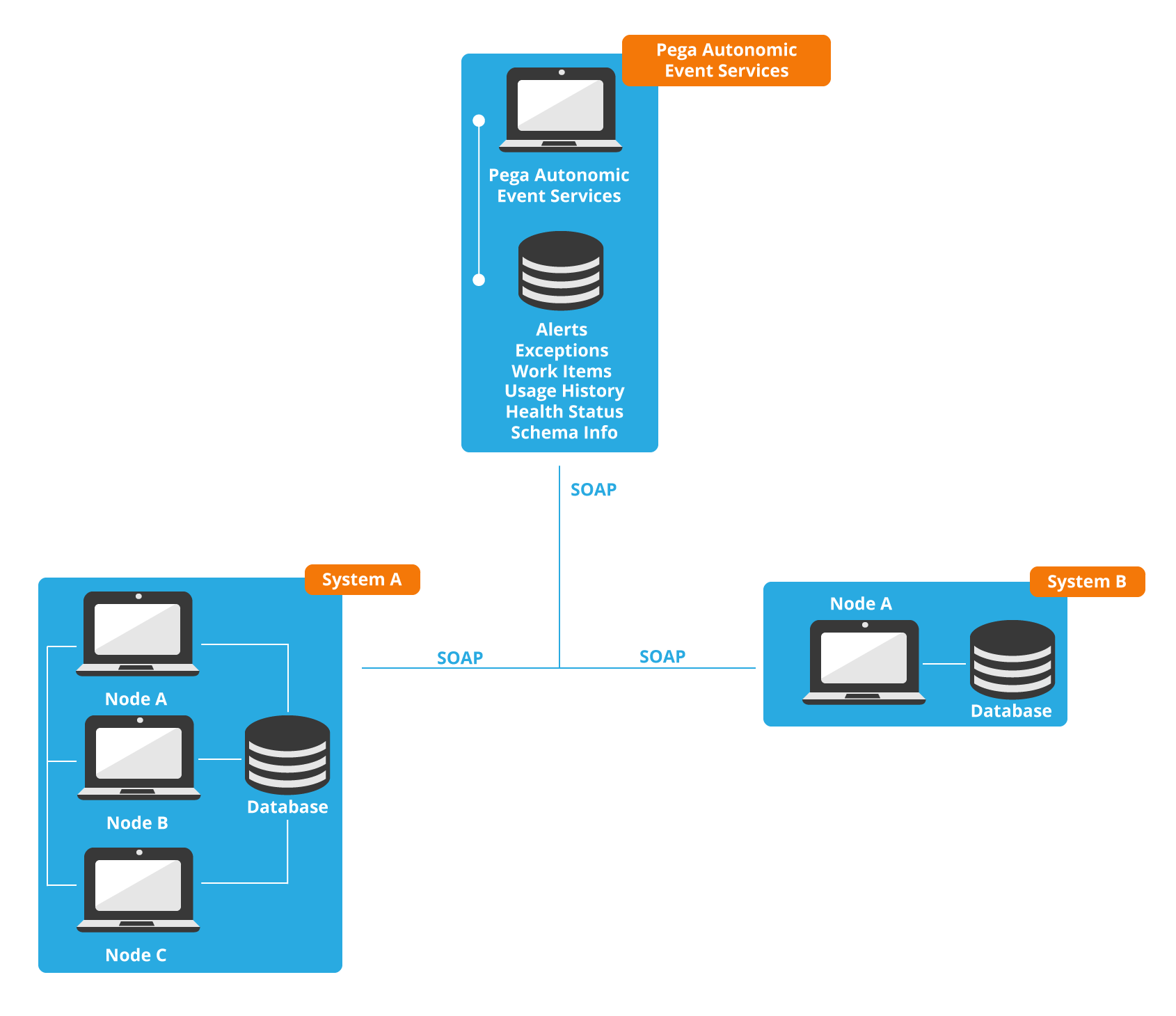Pega Autonomic Event Services 8.3 architecture overview and hardware requirements
Pega Autonomic Event Services 8.3 is an application that monitors the performance status of your Pega Platform™ systems. You install it on a stand-alone multitenant Pega Platform server. Planning your deployment requires that you are familiar with the application's architecture and hardware requirements.
Before making decisions about the server, database, and monitored systems, review the following information:
Architecture overview
The Pega Platform management daemon runs every two minutes and checks current system health, including memory usage, CPU usage, recent response time, requestor count, agent count, and the time of the last system pulse. After you enable the integration between a monitored system and Pega Autonomic Event Services, Pega Platform sends a Health Status (HLTH0001) message to Pega Autonomic Event Services via SOAP over HTTP or HTTPS.
Pega Platform includes the PegaAESRemote ruleset, which supports Pega Autonomic Event Services integration. When you enable integration between a monitored system and Pega Autonomic Event Services, agents in the ruleset periodically gather and send data to Pega Autonomic Event Services. This data contains a summary of the standard Pega Platform log usage records, as well as schema metadata, primarily consisting of index definitions. For more information, see Enhanced PegaAESRemote ruleset to support the latest Pega Autonomic Event Services features.
You install Pega Autonomic Event Services 8.3 on a Pega Platform 8.31 system with multitenancy enabled and the HFIX-59331 hotfix installed. For more information, see Installing Pega Autonomic Event Services 8.3 and Pega Autonomic Event Services hotfixes.
The following image is an overview of a typical Pega Autonomic Event Services deployment, and demonstrates the relationship between the application and monitored systems:

Alert processing
When a Pega Platform system generates alerts, it saves them in the alert log and sends them by using SOAP to Pega Autonomic Event Services. Pega Autonomic Event Services then parses the alerts and stores the records in the pegaam_alert database table. The application parses alert-specific data to determine how to correlate alerts with a similar root cause. Every five minutes, an agent accumulates recent alerts based on correlation, and either creates new cases for newly observed issues or updates the cases for existing issues. Pega Autonomic Event Services stores these cases in the pegaam_action_work table.
Exception processing
When a Pega Platform system generates exceptions, it sends them by SOAP to Pega Autonomic Event Services, which parses the exceptions and stores the records in the pegaam_exception database table. Depending on how often an exception occurs and the system events that triggered the exception, Pega Autonomic Event Services accumulates these records into exception cases. Pega Autonomic Event Services saves these cases in the database in the pegaam_exception_work table.
Hardware requirements
For optimal performance and reliability, ensure that you use production-grade servers with load balancing and failover for monitoring production deployments. As with any Pega Platform system, a Pega Autonomic Event Services deployment can grow based on needs and resource availability, but a starting deployment for Pega Autonomic Event Services 8.3 includes a dedicated database, load balancer, two WebUser nodes and a node to run agents.
Ensure that you use hardware with at least the following specifications:
- A dedicated database server with:
- 8 virtual processors (vCPUs)
- 64 GB RAM
- 750GB GB disk space
- 500 GB database
- PostgreSQL 11 with PG Stat Statements enabled
- Load balancer with sticky session support
- Two servers to run WebUser nodes:
- 4 vCPUs
- Tomcat 8 and Java 1.8
- 16 GB RAM
- 100 GB disk space
- 8 GB heap space
- A server to host a node to which you assign the following types: Search, BIX, BackgroundProcessing, Stream. For more information, see Classifying nodes.
- 4 vCPUs
- Tomcat 8 and Java 1.8
- 24 GB RAM
- 200 GB disk space
16 GB heap space
For additional information about system requirements, see the Pega Platform Installation Guide for your environment, available on the Deploy Pega Platform page.
Previous topic Pega Autonomic Event Services FAQ Next topic Installing Pega Autonomic Event Services 8.3
